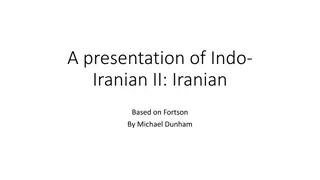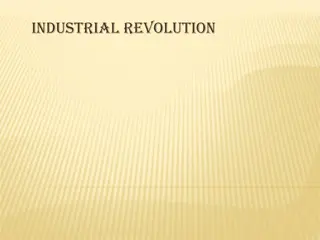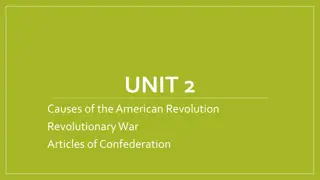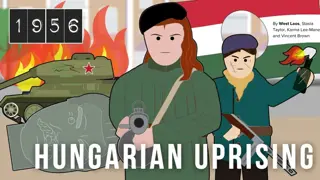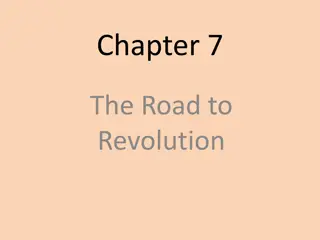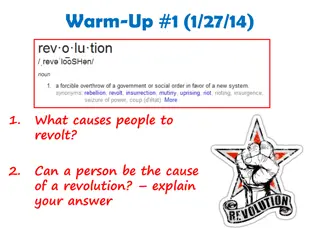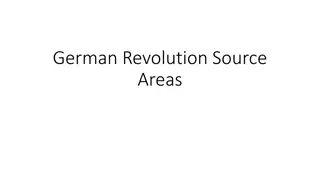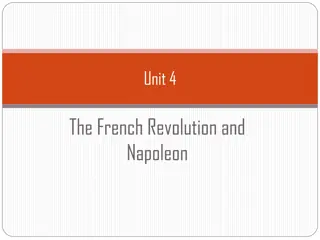The Iranian Revolution: Causes, Events, and Consequences
The Iranian Revolution of 1978-1979 was a significant event in history marked by widespread dissatisfaction with the rule of Mohammad Reza Shah Pahlavi, leading to his overthrow and the establishment of a new theocratic constitution under Ayatollah Ruhollah Khomeini. The revolution was fueled by grievances such as political repression, Western influence, and drastic social changes imposed by the Shah's regime. It culminated in massive demonstrations and the end of the Shah's rule, reshaping Iran's political landscape and global relations.
Download Presentation

Please find below an Image/Link to download the presentation.
The content on the website is provided AS IS for your information and personal use only. It may not be sold, licensed, or shared on other websites without obtaining consent from the author.If you encounter any issues during the download, it is possible that the publisher has removed the file from their server.
You are allowed to download the files provided on this website for personal or commercial use, subject to the condition that they are used lawfully. All files are the property of their respective owners.
The content on the website is provided AS IS for your information and personal use only. It may not be sold, licensed, or shared on other websites without obtaining consent from the author.
E N D
Presentation Transcript
Iranian Revolution (1978-1979)
Iranian Revolution/ Islamic Revolution WHY did the Iranian Revolution start?? The Iranian Revolution began when many Iranians and citizens within Iran were very dissatisfied with the rulership of the Iranian King, Mohammad Reza Shah Pahlavi. He replaced his father on the throne on September 16th, 1941. HOW and WHEN did the Iranian Revolution officially start?? It officially started in 1978 with the first major demonstration to overthrow the Shah [1]. In December 1979, the Revolution finally concluded with the Shah removed as ruler of Iran and with the approval of the new theocratic constitution. Ayatollah Ruhollah Khomeini took the place of the Shah with the approval of Iran. [1] Angry students and religious leaders in Qom, Iran, demonstrated against a false story attacking Khomeini (the man helping overthrowing the Shah) in the official press. The army was sent in, and killed many of the students.
Iranian Revolution The Iranian Revolution is considered the 3rd greatest revolution in history. On February 9th, 1979, million of Iranians came on to the streets of Teheran to welcome the return of the religious leader Ayatollah. He helped overthrow the much hated regime of the Shah. It was one of the largest demonstrations in human history (this shows how many people hated the Shah). WHY did the people hate the Shah so much? The Shah relied on manipulation and fear to lead the people. He esstablished a secret police ( SAVAK: spy on people and report back to the Shah). He closely identified himself with the West (U.S.) which was clashing with the Iranian, Muslim traditions. The Shah really made attempts to modernize Iran in 1953.
Iranian Revolution The Shah s regime involved changes within the Muslim traditions and ideologies which many citizens reacted strongly and negatively to. These traditions and ideologies involved: -banning of alcohol -banning of tobacco -banning of movies -gambling foreign dress -veil for women -punishments (cutting off the hand .)
IranianRevolution HOW was it a proxy war?? The Iranian revolution was a proxy war in the sense that the Shah used the secret police to deal directly with the people in Iran. Ex: SAVAK (secret police) set fire to the Cinema Rex in August, 1978, in Abadan. 400 people in the Cinema died.
Iranian Revolution WHERE America stands in the war: In 1978, the Shah turned to the United States for help and support. Iran had been pro America for quite a while, and Iran was important to America due to their history together and Iran s location. Therefore when the U.S. National Security Advisor Zbigniew Brzezinski repeatedly told the Shah that the U.S. would support him 100%, it was of no surprise. HOWEVER, after the U.S. thought about it some more they realized that the revolution was virtually unstoppable. Therefore, associating itself in the war and getting involved would be unwise for them. Nonetheless, the U.S. sent in some military troops anyway to help stabilize Iran. Thus Iran was ruling off of America s military and financial support.
Iranian Revolution Iran and America s bond broken: The Hostage Crisis: In November 1979, Iranian revolutionaries seized the U.S. embassy in Tehran and took the employees hostage. They young men held the employees captive for 444 days. This event is significant because it changed the way America viewed Iran. They were now seen in a negative light, and it shocked the U.S. as they were now brought into a world of Islamic fundamentalism. Ever since the event, Iran and the U.S. have been bitter adversaries.
Iranian Revolution TIMELINE 1941: Mohammad Reza Shah Pahlavi replaces father on the throne (father is exiled toAfrica). 1961: Husain Borujerdi (religious leader) dies and Khomeini takes his place. (Khomeini is the man the took the place of the Shah). He published a book called Society of Seminary Teachers of Qom, which played a key role in the revolution and its victory. 1963: The Shah proposes White Revolution . This is a six point reform bill to be put to a nation wide vote. However, Khomeini denounces the Shah s plans and the Shah exiles him and puts him under surveillance in Tehran. 1964: Khomeini is exiled to Tehran and doesn t return to Iran for 14 years.
Iranian Revolution TIMELINE 1978 (January): Hassan Ali Mansur (Prime Minister of Iran) is assassinated and Amir Abbas Hoveyda takes the place. 1978 ( Jan 7th):In a news paper called Black and Red Imperialism , was an article written about Khomeini proposing he was homosexual. 1978 ( Jan 9th):A demonstration of 4000 people against the article resulted in the death of many students. 1978 ( Feb 18th):Another protest against the Shah erupted in Tabriz. Around 100 people were killed. 1978 ( March 29th): Another demonstration in Yazd. More protestors are killed. 1978 ( August 12th):More protestors are killed in Isfahan. 1978 ( Aug 19th):Cinema Rex fire.
Iranian Revolution 1978 (Aug 27th):Jafar Sharif-Emami is Prime Minister and changes are made to the Shah s policies (no gambling). 1978 ( Sep 8th):Black Friday (the shah brings in tanks and military to break up a peaceful demonstrators and as a result, 88 people are dead. 1979 (Jan 16th):Shah leaves the country. 1979 (Dec 2nd):The New Constitution of Iran is approved with a 98% vote.
Iranian Revolution The outcome of the Iranian Revolution was a positive one for Iran. Much persecution had ended and their ideologies, religious, and cultural traditions were preserved. It resulted in peace in Iran and a better government. The revolution transformed Iran from a monarchy to an Islamic Republic.





